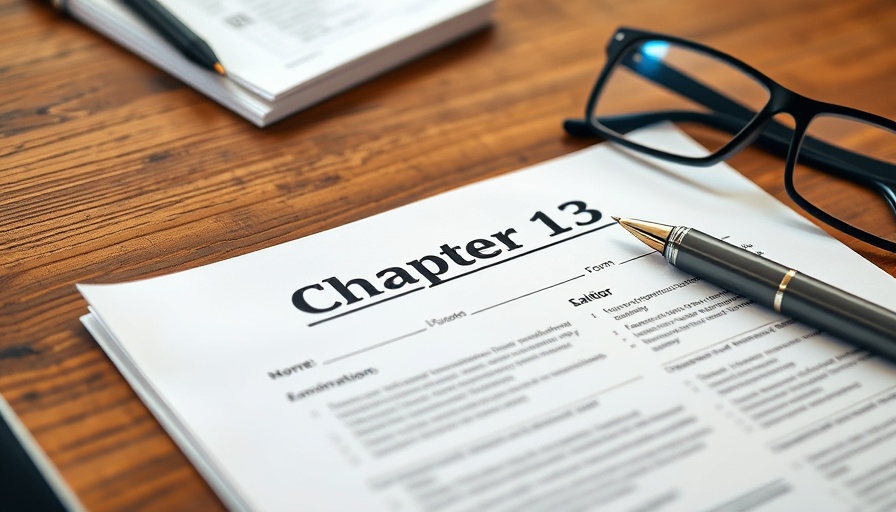
Understanding Chapter 13 Bankruptcy: More Than Just a Legal Term
Chapter 13 bankruptcy is often overlooked when talking about debt relief options, yet it can serve as a useful tool for many individuals struggling with financial obligations. Frequently referred to as a 'wage earner’s plan,' this legal safeguard provides a structured way for borrowers to reorganize their debts, allowing them to retain ownership of their assets while embarking on a repayment journey.
The Mechanics of Chapter 13 Bankruptcy
When a debtor files for Chapter 13 bankruptcy, an essential process begins. Unlike Chapter 7 bankruptcy, which requires liquidation of assets, Chapter 13 allows individuals to create a repayment plan lasting three to five years. During this time, all foreclosure actions are halted, providing much-needed breathing room. A bankruptcy trustee supervises the repayment, ensuring that creditors receive what is owed in a compliant manner. Ultimately, if debtors meet the repayment schedule, they can discharge eligible debts and start afresh.
Is Chapter 13 Bankruptcy Right for You?
Determining whether Chapter 13 is suitable often depends on various factors, including income, existing debt levels, and previous bankruptcy filings. Individuals with a reliable income source who owe under $2.75 million in secured and unsecured debt may find this route beneficial. Importantly, they must also complete credit counseling before filing, solidifying their commitment to better financial management.
Step-by-Step Breakdown of the Chapter 13 Process
Understanding the Chapter 13 process can demystify the experience for potential filers. The following steps represent the journey one must navigate to achieve a successful outcome:
- Complete Credit Counseling: Before diving in, individuals must consult with an approved credit counseling agency.
- File the Bankruptcy Petition: The initiation involves a legal submission that details financial particulars accompanied by a $310 filing fee.
- Submit a Repayment Plan: Within 14 days, filers must propose a repayment strategy to the court, with payments commencing typically within 30 days.
- Attend the 341 Meeting: This critical meeting invites creditors to question the debtor's financial history, enabling transparency.
- Go to the Confirmation Hearing: This is where the court evaluates the proposed repayment plan for approval, considering creditors' concerns.
Potential Benefits of Chapter 13 Bankruptcy
Exploring Chapter 13 reveals several advantages, one of the most significant being the opportunity to maintain assets. Furthermore, as this bankruptcy category helps individuals manage their finances, it can automatically stabilize credit scores, provided debtors adhere to repayment terms. By embracing this structured approach, many have successfully transitioned to a path of debt-free living.
Challenges Associated with Chapter 13 Bankruptcy
However, like every process, there are potential downsides. Payments can feel burdensome, especially for those already caught in a financial strain. Additionally, while debtors are allowed to retain their property, the repayment terms must be followed strictly to avoid complications. Missed payments may compromise the benefits of Chapter 13, pushing individuals back into a cycle of stress.
Alternatives to Chapter 13 Bankruptcy
Exploring Chapter 13 bankruptcy is essential, but it’s equally important to assess alternatives. Options like debt consolidation, debt settlement, or engaging in a debt management plan might be less intrusive measures for some. These methods can assist borrowers in finding balance while preserving their credit score.
Impact on Financial Health
Ultimately, understanding what Chapter 13 bankruptcy means goes beyond immediate relief; it highlights the importance of an informed approach to managing finances. By knowing the intricacies of available options, individuals can make strategic decisions that pave the way to efficient debt management and a healthier financial future.
Conclusion: Taking the Next Step
If you’re considering Chapter 13 bankruptcy as a solution, it’s imperative to consult a qualified debt advisor. They can guide you through the legal landscape and customize strategies that suit your unique situation. Understanding your options is the first step toward achieving debt-free living.
 Add Row
Add Row  Add
Add 



Write A Comment